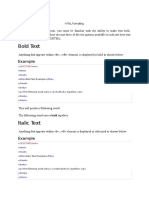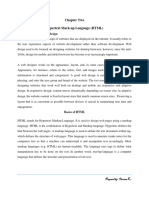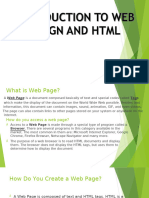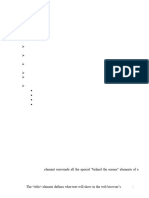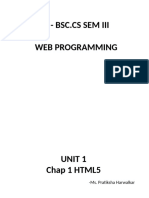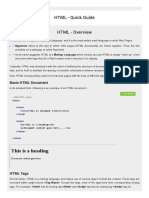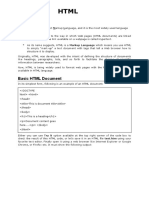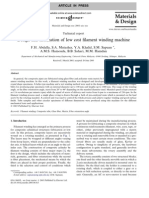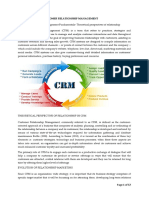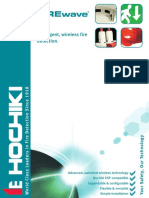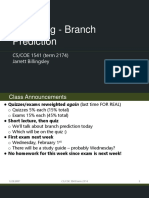0 ratings0% found this document useful (0 votes)
46 viewsLesson 4
Lesson 4
Uploaded by
Senneaya MelvinThe document discusses HTML formatting tags. It provides examples of how to format text as bold, italic, underlined, strikethrough, monospaced, superscript, subscript, and more. It also discusses using HTML tags to group content with <div> and <span> tags, emphasize and strengthen text, mark text, and abbreviate or quote text. The document concludes by explaining URLs and their main parts - the protocol, hostname, and directory/filename.
Copyright:
© All Rights Reserved
Available Formats
Download as PDF, TXT or read online from Scribd
Lesson 4
Lesson 4
Uploaded by
Senneaya Melvin0 ratings0% found this document useful (0 votes)
46 views30 pagesThe document discusses HTML formatting tags. It provides examples of how to format text as bold, italic, underlined, strikethrough, monospaced, superscript, subscript, and more. It also discusses using HTML tags to group content with <div> and <span> tags, emphasize and strengthen text, mark text, and abbreviate or quote text. The document concludes by explaining URLs and their main parts - the protocol, hostname, and directory/filename.
Original Title
lesson 4
Copyright
© © All Rights Reserved
Available Formats
PDF, TXT or read online from Scribd
Share this document
Did you find this document useful?
Is this content inappropriate?
The document discusses HTML formatting tags. It provides examples of how to format text as bold, italic, underlined, strikethrough, monospaced, superscript, subscript, and more. It also discusses using HTML tags to group content with <div> and <span> tags, emphasize and strengthen text, mark text, and abbreviate or quote text. The document concludes by explaining URLs and their main parts - the protocol, hostname, and directory/filename.
Copyright:
© All Rights Reserved
Available Formats
Download as PDF, TXT or read online from Scribd
Download as pdf or txt
0 ratings0% found this document useful (0 votes)
46 views30 pagesLesson 4
Lesson 4
Uploaded by
Senneaya MelvinThe document discusses HTML formatting tags. It provides examples of how to format text as bold, italic, underlined, strikethrough, monospaced, superscript, subscript, and more. It also discusses using HTML tags to group content with <div> and <span> tags, emphasize and strengthen text, mark text, and abbreviate or quote text. The document concludes by explaining URLs and their main parts - the protocol, hostname, and directory/filename.
Copyright:
© All Rights Reserved
Available Formats
Download as PDF, TXT or read online from Scribd
Download as pdf or txt
You are on page 1of 30
Lesson 4
• Links & Formatting HTML
• Biblical Relationships
• Gen. 2:18
• https://sites.google.com/a/
• babcock.edu.ng/maitanmi-
lecture-site/
objectives
At the end of the lesson, you should be able to:
• Use all the formatting tags in html or xhtml
• Know how to use links and anchors to link to specific places
inside pages
• Carry out all about URLs: the various parts of the URL and
the kinds of URLs you can use
• Specify the appearance of individual characters (bold, italic,
underlined)
• Include special characters (characters with accents,
copyright marks, and so on)
• Create preformatted text (text with spaces and tabs
retained)
• Align text left, right, and centered
• Change the font and font size
• Create other miscellaneous HTML text elements, including
line breaks, rule lines, addresses, and quotations
HTML – FORMATTING
Bold Text
Anything that appears within <b>...</b> element, is
displayed in bold as shown below:
<!DOCTYPE html>
<html>
<head>
<title>Bold Text Example</title>
</head>
<body>
<p>The following word uses a <b>bold</b> typeface.</p>
</body>
</html>
Italic Text
Anything that appears within <i>...</i> element is
displayed in italicized as shown below:
<!DOCTYPE html>
<html>
<head>
<title>Italic Text Example</title>
</head>
<body>
<p>The following word uses a <i>italicized</i>
typeface.</p>
</body>
</html>
Underline Text
Anything that appears within <u>...</u> element, is
displayed with underline as shown below:
<!DOCTYPE html>
<html>
<head>
<title>Underlined Text Example</title>
</head>
<body>
<p>The following word uses a <u>underlined</u>
typeface.</p>
</body>
</html>
Strike Text
Anything that appears within <strike>...</strike>
element is displayed with strikethrough, which is a
thin line through the text as shown below:
<!DOCTYPE html>
<html>
<head>
<title>Strike Text Example</title>
</head>
<body>
<p>The following word uses a
<strike>strikethrough</strike> typeface.</p>
</body>
Monospaced Font
The content of a <tt>...</tt> element is written in
monospaced font. Most of the fonts are known as variable-
width fonts because different letters are of different widths
(for example, the letter 'm' is wider than the letter 'i'). In a
monospaced font, however, each letter has the same width.
<!DOCTYPE html>
<html>
<head>
<title>Monospaced Font Example</title>
</head>
<body>
<p>The following word uses a <tt>monospaced</tt>
typeface.</p>
</body>
</html>
Superscript Text
The content of a <sup>...</sup> element is written in superscript;
the font size used is the same size as the characters surrounding
it but is displayed half a character's height above the other
characters.
<!DOCTYPE html>
<html>
<head>
<title>Superscript Text Example</title>
</head>
<body>
<p>The following word uses a <sup>superscript</sup>
typeface.</p>
</body>
</html>
Subscript Text
The content of a <sub>...</sub> element is written in
subscript; the font size used is the same as the characters
surrounding it, but is displayed half a character's height
beneath the other characters.
<!DOCTYPE html>
<html>
<head>
<title>Subscript Text Example</title>
</head>
<body>
<p>The following word uses a <sub>subscript</sub>
typeface.</p>
</body>
</html>
Exercises
Produce the followings using the formatted tags
studied.
H2o
6x2 +4x+6 = 0
Strike through
Deleted & Inserted Text
Anything that appears within <ins>...</ins> element is
displayed as inserted text. Anything that appears within
<del>...</del> element, is displayed as deleted text
<!DOCTYPE html>
<html>
<head>
<title>Inserted Text Example</title>
</head>
<body>
<p>I want to drink <del>cola</del> <ins>wine</ins></p>
</body>
</html> OUTPUT
Larger Text & Smaller Text
The content of the <big>...</big> and<small>..</small>
element is displayed one font size larger than the rest of
the text surrounding it as shown below:
<!DOCTYPE html>
<html>
<head>
<title>Larger Text Example</title>
</head>
<body>
<p>The following word uses a <big>big</big>
typeface.</p>
<p>The following word uses a <small>small</small>
typeface.</p>
</
</body>
</html>
Grouping Content
The <div> and <span> elements allow you to group
together several elements to create sections or
subsections of a page. For example, you might want to put all
of the footnotes on a page within a <div> element to indicate
that all of the elements within that <div> element relate to
the footnotes. You might then attach a style to this <div>
element so that they appear using a special set of style rules.
<!DOCTYPE html>
<html>
<head>
<title>Div Tag Example</title>
</head>
<body>
<div id="menu" align="middle" >
<a href="/index.htm">HOME</a> |
<a href="/about/contact_us.htm">CONTACT</a> |
<a href="/about/index.htm">ABOUT</a>
</div>
<div id="content" align="left" bgcolor="white">
<h5>Content Articles</h5>
<p>Actual content goes here.....</p>
</div>
</body>
</html>
The <span> element
• This is used to group inline elements only. So, if you
have a part of a sentence or paragraph which you want
to group together, you could use the <span> element
as follows:
<!DOCTYPE html>
<html>
<head>
<title>Span Tag Example</title>
</head>
<body>
<p>This is the example of <span style="color:green">span
tag</span> and the <span style="color:red">div
tag</span> alongwith CSS</p>
</body>
</html>
Emphasized & Strong Text
Anything that appears within <em>...</em> element is
displayed as emphasized text. Also, anything that
appears within <strong>...</strong> element is
displayed as important text
<!DOCTYPE html>
<html>
<head>
<title>Emphasized Text Example</title>
</head>
<body>
<p>The following word uses a <em>emphasized</em>
typeface.</p>
<p>The following word uses a <strong>strong</strong>
typeface.</p>
</body>
</html>
Marked Text
Anything that appears with-in <mark>...</mark>
element, is displayed as marked with yellow ink.
<!DOCTYPE html>
<html>
<head>
<title>Marked Text Example</title>
</head>
<body>
<p>The following word has been
<mark>marked</mark> with yellow</p>
</body>
</html> OUTPUT
Text Abbreviation
You can abbreviate a text by putting it inside opening
<abbr> and closing </abbr> tags. If present, the title
attribute must contain this full description and nothing
else.
<!DOCTYPE html>
<html>
<head>
<title>Text Abbreviation</title>
</head>
<body>
<p>My best friend's name is <abbr
title="Abhishek">Abhy</abbr>.</p>
</body>
</html>
Acronym Element
The <acronym> element allows you to indicate that
the text between <acronym> and </acronym> tags
is an acronym.
<!DOCTYPE html>
<html>
<head>
<title>Acronym Example</title>
</head>
<body>
<p>This chapter covers marking up text in
<acronym>XHTML</acronym>.</p>
</body>
</html>
Text Direction
The <bdo>...</bdo> element stands for Bi-Directional
Override and it is used to override the current text
direction.
<!DOCTYPE html>
<html>
<head>
<title>Text Direction Example</title>
</head>
<body>
<p>This text will go left to right.</p>
<p><bdo dir="rtl">This text will go right to left.</bdo></p>
</body>
</html>
Special Terms
The <dfn>...</dfn> element (or HTML Definition Element)
allows you to specify that you are introducing a special term.
It's usage is similar to italic words in the midst of a paragraph.
<!DOCTYPE html>
<html>
<head>
<title>Special Terms Example</title>
</head>
<body>
<p>The following word is a <dfn>special</dfn> term.</p>
</body>
</html>
Quoting Text
When you want to quote a passage from another source, you
should put it in btw <blockquote>...</blockquote> tags.
<!DOCTYPE html>
<html>
<head>
<title>Blockquote Example</title>
</head>
<body>
<p>The following description of XHTML is taken from the W3C Web
site:</p> <blockquote>XHTML 1.0 is the W3C's first
Recommendation
for XHTML, following on from earlier work on HTML 4.01, HTML 4.0,
HTML 3.2 and HTML 2.0.</blockquote>
</body>
</html>
Other formatting tags
• Short Quotation
• Text Citation
• Computer Code
• Keyboard text
• Programming Variables
• Program Outputs
• Address text
Uniform Resource Locators (URLs)
• URLs are street addresses for bits of
information on the Internet.
Parts of URL
• Most URLs contain (roughly) three parts: the
protocol, the hostname, and the directory or
filename as seen in Figure 3.42
Figure 3.42: Parts of URL
Protocol
The protocol is the way in which the page is
accessed; that is, the means of
communication your browser uses to get the
file. If the browser uses HTTP or HTPPS to get
to the file, the protocols part is http or https. If
the browser uses FTP, the protocol is ftp. The
protocol matches an information server that
must be installed on the system for it to work.
You can’t use an FTP URL on a machine that
does not have an FTP server installed.
Hostname
The hostname is the Internet system on which the
information is stored, such as
• www.netcom.com,
• ftp.apple.com,
• or www.aol.com.
You can have the same hostname but have different
URLs with different protocols, such as the following:
http://mysystem.com
ftp://mysystem.com
It’s one machine that offers two different information
services, and the browser will use different methods of
connecting them. As long as all the servers are
installed and available on that system, you won’t have
a problem.
Hostname Cont’d
• The hostname part of the URL might include a port
number. The port number tells your browser to
open a connection using the appropriate protocol
on a specific network port. The only time you’ll
need a port number in a URL is if the server
responding to the request has been explicitly
installed on that port. If the server is listening on
the default port, you can leave the port number
out.
• If a port number is necessary, it’s placed after the
hostname but before the directory, as follows:
• http://my-public-access-unix.com:1550/pub/file
You might also like
- What Is HTML?Document36 pagesWhat Is HTML?Anand TiwariNo ratings yet
- HTMLDocument86 pagesHTMLHarsh MendaparaNo ratings yet
- Class: XII Subject: Computer: Features of HTMLDocument40 pagesClass: XII Subject: Computer: Features of HTMLnidhi singhNo ratings yet
- Web Technology: Code:Cacs205 Facilitator Krishna Pd. AcharyaDocument46 pagesWeb Technology: Code:Cacs205 Facilitator Krishna Pd. AcharyaPiyush KoiralaNo ratings yet
- Build Simple Websites Using Commercial ProgramsDocument51 pagesBuild Simple Websites Using Commercial ProgramsIsrael EyasuNo ratings yet
- HTML Short NotesDocument17 pagesHTML Short NotesSakshi SwatiNo ratings yet
- HTML Tutorials1Document134 pagesHTML Tutorials1Shanmuka SreenivasNo ratings yet
- Lecture 0Document59 pagesLecture 0Aditya Pratap SinghNo ratings yet
- Web - Technologies PPT Unit 1Document326 pagesWeb - Technologies PPT Unit 1Kedar MahalleNo ratings yet
- HTMLBasicsDocument60 pagesHTMLBasicsChaitanyaNo ratings yet
- Fundamentals of HTML: Hypertext Refers To The Way in Which Web Pages (HTML Documents) Are Linked TogetherDocument31 pagesFundamentals of HTML: Hypertext Refers To The Way in Which Web Pages (HTML Documents) Are Linked TogetherArshdeep SinghNo ratings yet
- Introduction To HTMLDocument17 pagesIntroduction To HTMLVero NicaNo ratings yet
- Lecture 5 - HTML AttributesDocument54 pagesLecture 5 - HTML AttributesTanveer Ahmed HakroNo ratings yet
- HTML NotesDocument14 pagesHTML Notessujitasahu234No ratings yet
- Chapter TwoDocument20 pagesChapter Twokaleb123 shumu12No ratings yet
- Html class notesDocument124 pagesHtml class notesbakwaskaam1173No ratings yet
- Module 4Document15 pagesModule 4vankarkelvin258No ratings yet
- HTML TutorialDocument55 pagesHTML TutorialRaviRahulNo ratings yet
- Unit-1 Exposure To HTMLDocument51 pagesUnit-1 Exposure To HTMLsnippet oneNo ratings yet
- HTMLDocument21 pagesHTMLEndaleNo ratings yet
- Learning HTMLDocument38 pagesLearning HTMLIX-B-MAYANK YADAV (5466)100% (1)
- Key Concepts: 2.1 Introduction To Hyper Text Markup Language (HTML)Document66 pagesKey Concepts: 2.1 Introduction To Hyper Text Markup Language (HTML)NancyNo ratings yet
- Fswd@unit 1@aimlDocument56 pagesFswd@unit 1@aimlrowthulalokeshNo ratings yet
- HTMLDocument58 pagesHTMLAakanksha ThodupunooriNo ratings yet
- HTML Training by ThiruDocument122 pagesHTML Training by ThiruKumaran RNo ratings yet
- MM 1st Unit Notes SumDocument30 pagesMM 1st Unit Notes Sumaprnamili2No ratings yet
- Static Web Sites: 1. Differentiate Static and Dynamic Website Briefly?Document8 pagesStatic Web Sites: 1. Differentiate Static and Dynamic Website Briefly?hak advNo ratings yet
- Chapter-II(Introduction of HTML)Document30 pagesChapter-II(Introduction of HTML)citecollege301No ratings yet
- Lab-8-HTML BasicsDocument14 pagesLab-8-HTML BasicsMujtaba SaleemNo ratings yet
- HTML CommandsDocument33 pagesHTML Commandstojerix332No ratings yet
- HTML ExamplesDocument11 pagesHTML Examplesmithilesh bidkarNo ratings yet
- HTMLDocument41 pagesHTMLweyes423No ratings yet
- HTML NotesDocument54 pagesHTML Notesvarinder singhNo ratings yet
- chap 1 HTML5Document110 pageschap 1 HTML5Shikha SharmaNo ratings yet
- What Is HTML????Document12 pagesWhat Is HTML????naushinaliNo ratings yet
- 1c HTML Overview-1Document8 pages1c HTML Overview-1maxmanuu001No ratings yet
- 0 - HTML Notes For BCADocument22 pages0 - HTML Notes For BCAvandv prints100% (4)
- HTML N HTML 5 TutorialDocument143 pagesHTML N HTML 5 TutorialRohit Actuarian100% (1)
- 7-HTML - FormattingDocument7 pages7-HTML - FormattingPankaj MauryaNo ratings yet
- HTML PracticeDocument35 pagesHTML PracticeKIPUTA JRNo ratings yet
- HTML TutorialDocument41 pagesHTML TutorialChelz Kyzlee D. AgnoteNo ratings yet
- HTML NotesDocument39 pagesHTML Noteskoshika.lambaNo ratings yet
- Web U1Document79 pagesWeb U1gvenkataprasad1234No ratings yet
- UNIT-1Document19 pagesUNIT-1diwyanshshukla8888No ratings yet
- Lab UNIT-3Document26 pagesLab UNIT-3dr.shashiprabhaNo ratings yet
- Web Design Technologiesmodule-1 - PartaDocument66 pagesWeb Design Technologiesmodule-1 - Partachandan kumarNo ratings yet
- HTML - Quick GuideDocument141 pagesHTML - Quick GuideSampath DarshanaNo ratings yet
- HTML TutorialDocument474 pagesHTML TutorialHarrySinghKhalsaNo ratings yet
- Web Page Development: Information & Communication Technology - 2006Document62 pagesWeb Page Development: Information & Communication Technology - 2006njk19100% (1)
- HTML ContentDocument40 pagesHTML ContentPushp RanjanNo ratings yet
- HTML and CSSDocument93 pagesHTML and CSSHimanshu SachdevaNo ratings yet
- HTML TutorialDocument47 pagesHTML Tutorialben munjaruNo ratings yet
- Basic Web DevelopmentDocument27 pagesBasic Web DevelopmentlorenaNo ratings yet
- HTML Cha1Document49 pagesHTML Cha1အောင်ပိုင် ဖြိုးNo ratings yet
- HTML Notes For BeginnersDocument10 pagesHTML Notes For BeginnersAman Baranwal100% (1)
- Lesson 3Document23 pagesLesson 3Senneaya MelvinNo ratings yet
- HTML N HTML 5 TutorialDocument143 pagesHTML N HTML 5 Tutoriallaki lakiNo ratings yet
- Chapter 2 BlockchainDocument7 pagesChapter 2 BlockchainFarheen AkramNo ratings yet
- C320 Device Manual enDocument54 pagesC320 Device Manual enGerman6419No ratings yet
- Set Hold BasicsDocument17 pagesSet Hold BasicsMelissa AdamsNo ratings yet
- Spardha Pariksha Genius 2016 - Exam GuidelinesDocument13 pagesSpardha Pariksha Genius 2016 - Exam GuidelinesAbhijit ThoratNo ratings yet
- T1 Relational DatabaseDocument19 pagesT1 Relational DatabaseZKHongNo ratings yet
- High Court of Gujarat,: Sola, Ahmedabad: 380 060Document11 pagesHigh Court of Gujarat,: Sola, Ahmedabad: 380 060TopRankersNo ratings yet
- CERGAS Software SWE60 Manual de UsoDocument40 pagesCERGAS Software SWE60 Manual de UsoMajid MohammadianNo ratings yet
- UN46ES6100 ch.U76A PDFDocument80 pagesUN46ES6100 ch.U76A PDFboroda241050% (2)
- Assignment On Business PlanDocument28 pagesAssignment On Business PlanFauzia AfrozaNo ratings yet
- Getting Started Guide: SimulinkDocument93 pagesGetting Started Guide: SimulinkJ. M. M.No ratings yet
- Lesson 4: Educational Technology and Innovative TeachingDocument4 pagesLesson 4: Educational Technology and Innovative TeachingTerry ReyesNo ratings yet
- Service Code and Password For Medical Equipments PDF FreeDocument3 pagesService Code and Password For Medical Equipments PDF Freekienson.bkmedNo ratings yet
- Sample Alv ReportsDocument51 pagesSample Alv ReportsPavan100% (1)
- OpenShift - Container - Platform 4.17 Architecture en USDocument82 pagesOpenShift - Container - Platform 4.17 Architecture en USrobertjspereiraNo ratings yet
- Design and Fabrication of Low Cost Filament Winding MachineDocument6 pagesDesign and Fabrication of Low Cost Filament Winding MachineAbdalla HamedNo ratings yet
- PMSO SyllabusDocument5 pagesPMSO Syllabusuvesh shaikhNo ratings yet
- Sylabus Combined Ad No 08 2018Document26 pagesSylabus Combined Ad No 08 2018Faisal HaYatNo ratings yet
- Chapter 20Document99 pagesChapter 20Maximilianus TjenderasaNo ratings yet
- CRM NotesDocument57 pagesCRM Notesshobhit parasharNo ratings yet
- The Shepherd Journal, April 1, 2011Document2 pagesThe Shepherd Journal, April 1, 2011J.A.MorganNo ratings yet
- As 3500 1 1 1998 National Plumbing and Drainage Water Supply Performance Requirements PDFDocument7 pagesAs 3500 1 1 1998 National Plumbing and Drainage Water Supply Performance Requirements PDFMac ShaikNo ratings yet
- Hochiki FIREwave OverviewDocument6 pagesHochiki FIREwave OverviewvigneshNo ratings yet
- Physics72.1 Activity ManualDocument131 pagesPhysics72.1 Activity ManualJay Jay0% (1)
- BSBADM409 Learner Guide V1.2Document65 pagesBSBADM409 Learner Guide V1.2AlexDrive100% (1)
- GIS Lab7Document6 pagesGIS Lab7Muhammad UsmanNo ratings yet
- As Cyber Attacks On Cars Rise, So Does Related CybersecurityDocument4 pagesAs Cyber Attacks On Cars Rise, So Does Related CybersecurityMilan SharmaNo ratings yet
- Riccar 551 Sewing Machine Instruction ManualDocument45 pagesRiccar 551 Sewing Machine Instruction ManualiliiexpugnansNo ratings yet
- 05 - Pipelining - Branch PredictionDocument20 pages05 - Pipelining - Branch PredictionShruthi PalemNo ratings yet
- PrinceDocument2 pagesPrincePrince SharmaNo ratings yet







